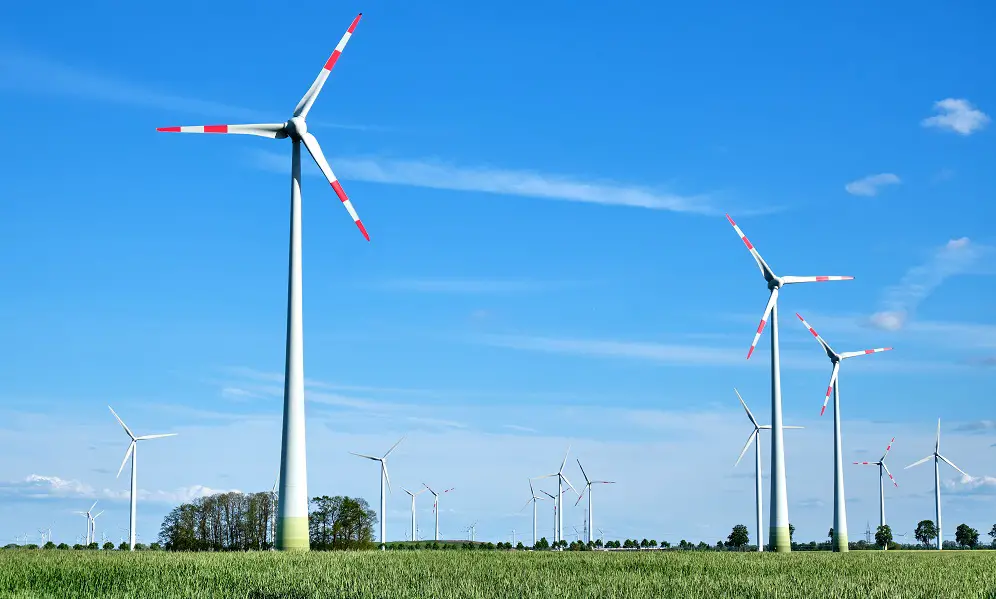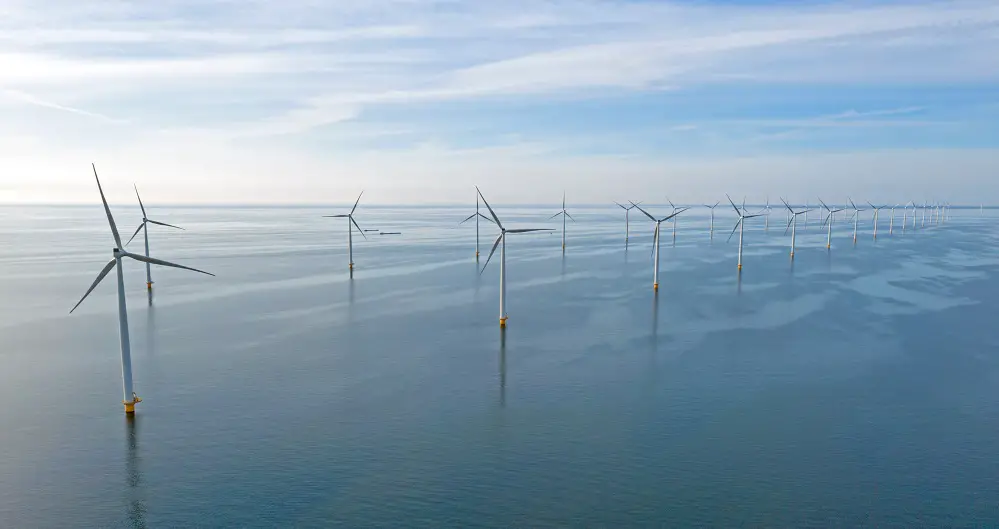The vast majority of wind turbines are painted white for aesthetic reasons, so as not to become an eyesore or a blot on the landscape. There are more practical reasons too, including safety, longevity, and protection.
Surprisingly, white paint can extend the life span of a wind turbine.
What is a Wind Turbine

Wind turbines harness kinetic energy from the wind before converting it into electric energy.
The tall tower-like structure captures wind via the blades, from there it goes to a generator to have voltage added. The electricity is then sent to substations, and then on to the National Grid. From here it is distributed to various outlets.
Why Wind Turbines Are White?
There are three main reasons:
Aesthetics
It is hard to believe that a structure that stands up to 460-feet tall needs to blend into the background, but for those who regularly have to look at them, neutrality is understandable.
Wind turbines have to remain fully-functional whilst not creating an eye-sore, and white paint achieves this. Luminous and dark colors are more obvious in most environments, particularly natural ones.
Thoughts of painting them blue or green are scuppered when, from an eye-level perspective, white turbines stand out against scenery or sky. Imagine a grey, dull day; blue wind turbines would stand out with that as the backdrop where the white turbine blends in.
White appears to be the happy medium, the most unobtrusive color that least offends anyone.
Safety

Contrary to everything that you have just read, for a particular demographic, wind turbines should stand out like a beacon.
Pilots need to be fully aware of the proximity of the tall structures at all times.
White is the boldest color choice to stand out against almost all environments.
By law, pilots should have a clear and unrestricted view of wind turbines at all times.
In Germany and some other European countries, the blades of the turbines are marked with red banding. The number of bands denotes the nearness of the airport or landing strip.
Wind turbines close to busy flight paths are often fitted with flashing red lights to alert pilots.
It is in these same countries that the bases of wind turbines are sometimes painted green. This helps them to blend in with grass and softens their overall appearance.
Protection
Dark colors absorb the harmful UV rays from the sun. Where-as light colors, particularly white, reflect them.
Ultra-violet degrades materials over time, particularly paintwork. This causes it to blister and crack, resulting in regular, expensive maintenance.
It can also weaken the structural integrity of the blades, reducing their life expectancy.
Dark colors also absorb heat from the sun. This can damage the internal components of the turbine and create premature wear and tear. Heat expands working parts, resulting in over-heating and mechanical breakdown.
The generator is where the kinetic energy is converted to electrical energy. If the generator becomes over-heated the wind turbine could experience total system failure.
All moving metal components require lubrication to prevent them from grinding together.
Dark-colored paintwork absorbs the heat from the sun causing the lubricant to dry out. This creates friction of the interior metal parts.
All of the above is avoided by using white paint which reflects sunlight.
Are Any Other Colors Suitable for Wind Turbines
No hard and fast rule says all wind turbines should be white. In fact, some wind farmers experiment with grey. They feel the color blends into the surroundings better whilst remaining obvious to pilots.
There is a negative to using brilliant white paint; bugs and insects are unfathomably drawn to it.
The creatures land when the turbines are still and are problematic to get rid of.
Areas that insects choose to colonize immediately become rife with their predator like birds and bats.
Birds base the majority of their nesting decisions on the nearness of a constant, viable food source.
It is felt that wind turbines contribute to the decline of some bird species as they get killed by the moving blades. Wind farmers state that although this does happen, casualties are minimal.
Although the white paint acts as a magnet to insects, much as the brightest colored flowers do, it might not be the only attraction for the insects. The humming sound of the motor and the blades as they cut through the air also appeals to them, as does the differing air current.
Does Darker Painted Wind Turbines Repel Insects?
Scientific testing proved that insects were drawn to white and yellow paint predominantly, and steered clear of purple.
However, we are not sure if this is enough of a case for purple to be used on wind turbines in the future.
Are Offshore Wind Turbines White?

Offshore wind turbines are constructed in bodies of water, usually the ocean. They take advantage of the much higher wind speeds, making them capable of generating a greater amount of electricity.
Just as the wind turbines on land are white, so are offshore structures.
They are incredibly expensive to build and to erect, their construction has to be robust enough to survive for 25-years in very extreme conditions.
White is the obvious color choice as it reflects harmful UV rays and their subsequent heat.
Protecting all of the internal components from heat damage is paramount and white paint is responsible for this which helps to keep maintenance costs low.
The turbines are usually built on highly-visible, yellow foundations. This helps to guide ships into dock whilst also acting as a hazard/warning sign, preventing them from coming too close.
When visibility is poor at sea, the combination of the yellow foundation and brilliant white tower is enough to alert crew members.
Final Thoughts
Wind is an abundant, clean, and free renewable energy source. The only way to harness their power is by using a wind turbine. Many people have a NIMBY or Not In My Back Yard attitude towards them.
This is part of the reason why wind turbines are white, to cause as little invasion to everyday life as possible.
Other than that, white wind turbines have by far the longest life expectancy of any other color.

